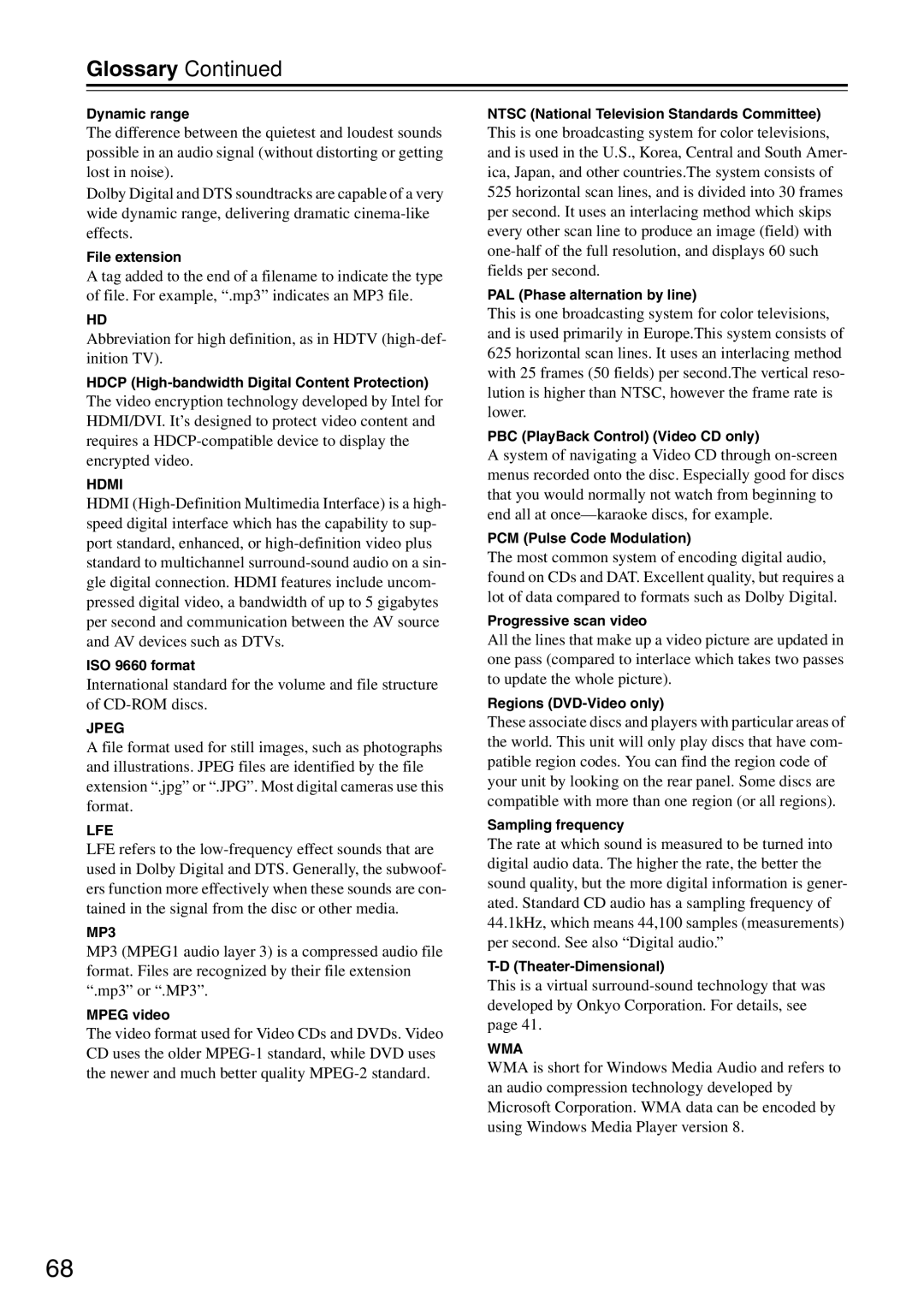DSR-4.8
Important Safety Instructions
Batteries
Installing this Unit
Precautions
Power
Precautions
For models having a power cord with a polarized plug
FCC Information for User
Sur les modèles dont la fiche est polarisée
Supplied Accessories
Make sure you have the following accessories
Features
Introduction
Contents
Introduction
Disc Notes
Supported Discs
Function Support
Cleaning Discs
MP3/WMA/JPEG Compatibility
About WMA
Handling Discs
Copyright
Using the Remote Controller
Before Using the DVD receiver
Installing the Batteries
Front & Rear Panels
Front Panel
Front & Rear Panels
Display
Rear Panel
Remote Controller
Resolution button
Tuner buttons Tuning / button
Preset Buttons
Mode button
Placing the Speakers
Connecting the DVD receiver
Connecting Your Speakers
Connecting the DVD receiver
Connecting Antenna
Connecting the Speaker Cables
Connecting a Powered Subwoofer
Connecting the AM Loop Antenna
Connecting an Outdoor FM Antenna
Using a TV/FM Antenna Splitter
Supplied indoor AM loop antenna is for indoor use only
Connecting an Outdoor AM Antenna
AV Cables & Connectors
Video Output/Video Setting Matrix
Video Signal Flow Chart
Basic Setup
Before Making Any Connections
RCA AV Connection Color Coding
Optical Digital Jacks
Connecting Your TV video connection
Connecting Other AV Component
Using Component Video
Compatibility of this unit with progressive-scan TVs
Connecting an RI Dock
Digital Audio Connection
What is HDMI?
Using Hdmi
Hdmi & the DVD receiver
Video
Using a Multiroom Kit with Other Components
Using the Multiroom Control Kits
Using a Multiroom Kit with a Cabinet
Standby/On Standby indicator
Connecting the Power/Turning on the DVD receiver
Before connecting
Initial Setup
First Time Setup
Use the Up and Down
Buttons to select TV Shape
Selecting Progressive or Interlaced
Hdmi and Progressive Settings
Setting the Hdmi
Adjusting the Volume
Using Headphones
Understanding Common Operations
Selecting the Input Source
Using the Sleep Timer
Adjusting Subwoofer Level
Remote controller Press the Muting button
Understanding Common Operations
Starting, Pausing & Stopping Playback
Playing Discs
Playing Discs
Select Next & Previous track/chapter
Stop To stop playback, press the Stop
Select
This section explains how to fast forward and reverse
Forward Frame-by-Frame Playback
Fast Forward & Reverse
To resume normal playback, press Play button
Navigating DVD & VCD Disc Menus
Navigating CDs & Super Audio CDs
Navigating MP3 & WMA Discs
Viewing a Slideshow of Jpeg Images
Load a Jpeg disc
To stop the slideshow, press the Stop or Menu button
To display thumbnails
Using the Tuner
Tuning into Radio Stations
Listening to the Radio
Listening to the Radio
Presetting AM/FM Stations
Selecting Presets
Deleting Presets
Listening to the Radio
About the Listening Modes
Using the Listening Modes
Selecting Listening Modes
Using the Listening Modes
Theater-Dimensional Listening Angle Setting
Listening Mode and Receiver Settings
Press and hold the Setup but Ton for 3 seconds
Advanced Playback
Press the Search button
Press the Play or Enter but
Ton to start playback of the spec
Advanced Playback
Searching by Time
During playback, press the Search button twice
Use the number buttons to enter a time
To cancel A-B repeat playback, press the A-B button
Repeat Playback
Repeat A- appears onscreen and -RA appears on the display
Repeat
Random
Random Playback
SACD, VCD, CD Disc Random, Ran- dom Off
Memory Playback
Adding New Items to the List
Editing Steps
Last Memory
Deleting Items from the List
Zooming
Selecting Camera Angles
Zoom x1.0 appears onscreen
Press the Zoom again repeat- edly to Zoom
Selecting Soundtracks
Selecting Subtitles
Disc and Input Information
Displaying Information
Disc Information
Input Information
Entering Remote Control Codes
Controlling Other Components
Controlling a TV connected to the DVD receiver
Controlling a TV
Controlling Other Components
Configuring the DVD receiver
Setup Menu
Audio Input Setup
Digital Input Signal Formats
Configuring the DVD receiver
Audio Input Setup
Digital Input Signal Formats
Input Default assignment
Crossover Frequency
DVD Onscreen Setup Menus
DVD Onscreen Setup Menus
Using the Onscreen Setup Menus
When you’ve finished, press
Setup button again
View Mode
Hdmi Output Setting
Picture Menu
TV Shape
Progressive Setting
HD Resolution
HD Jpeg Mode
Video Black Level
Audio Menu
Language Menu
When you’ve finished, press the Enter button
Use this list when specifying other languages
Selecting Other Languages
Select Others from the Disc Menu Language, Audio Lan
Display Menu
On-Screen Display
On-Screen Display Color
Background
Operation Setting Menu
Setting the Parental Lock
Change the Security Code
Tal lock, and then press
DVD Priority Contents
Sacd Priority Contents
Resetting the receiver
Disc Content Organization
Additional information
DVD-Video regions
MP3, WMA & Jpeg Files
Glossary
Additional information
Hdcp High-bandwidth Digital Content Protection
PAL Phase alternation by line
Dynamic range
File extension
Audio
Troubleshooting
Power
Make sure the source material is Dolby Digital
Troubleshooting
Video
Tuner
Disc Playback
Set the DVD Priority Contents setting to DVD-VIDEO
Set the Sacd Priority Contents setting to Multi ch Area
Connection with External Devices
Disc may have been illegally copied
Hdmi Status Mode
No picture from the Hdmi connection
Displayed ID Message
Hdcp
Specifications
Amplifier Section
Video Section
Tuner Section
Remote Control Codes List
Remote Control Codes List
KEC
KLH
KLL
KTV
RCA
SBR
SEG
SKY
TV/DVD Combination
3 4 4 5 6
